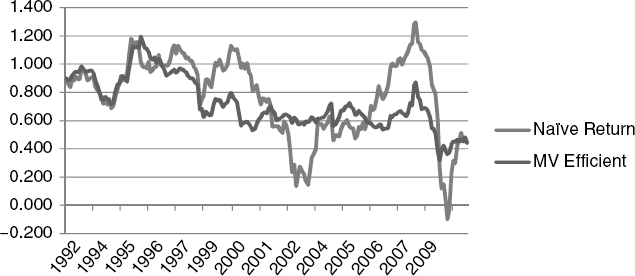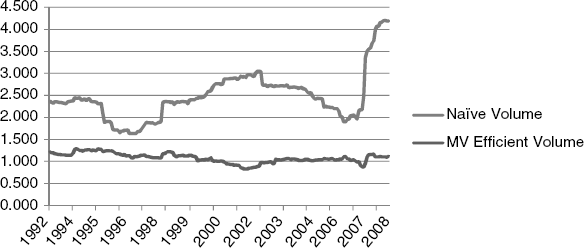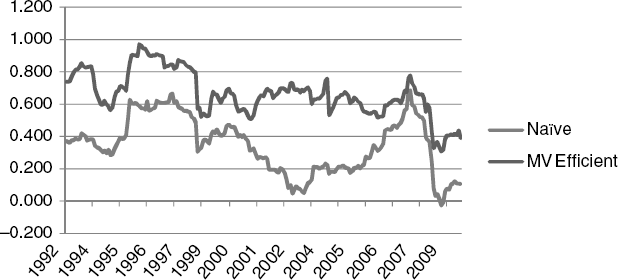Behavioral Finance
Why does the CAPM fail? Surely, if prices deviate from fundamentals, then mispricing will be profitably exploited by rational agents. If mispricing persists, then this anomaly may reflect something else; for example, the notion that the book-to-market factor (HML) in the Fama and French three-factor model explains the overreaction anomaly that the single-factor CAPM cannot. The anomalies discussed in the previous section suggest that either the model is misspecified in the sense that risk factors are missing (Eugene Fama's argument) or that the behavior implicit in the model—rational agents with identical preferences acting as mean variance optimizers—is not representative of the underlying market dynamic.
The theory of rational expectations posits that agents’ subjective distributions of outcomes coincide with nature's objective distribution of outcomes, that is, that agents’ models are correctly specified. This is a strong assumption. In fact, agents’ information sets are asymmetric and their models are at best incomplete. Even with learning, agents’ behavior may not be able to adjust adequately to ensure convergence to rational expectations equilibria. In short, equilibrium pricing models like the CAPM as well as the notion of efficient markets may fall victim to various imperfections in the rational paradigm.
Mainstream economics finds comfort in the argument that markets are self-correcting; that irrational agents will present arbitrage opportunities to rational agents and that inefficiencies will effectively be arbitraged away. Fisher Black presented an intriguing counterexample of agents who think they are trading on information but are, in fact, trading on transitory noise (Black 1986). The traditional model of arbitrage suggests that noise traders provide liquidity to the market that is exploited by rational arbitrageurs who, acting on superior information, absorb noise traders’ capital, thus eliminating them from the market. Under these circumstances, noise traders cannot rationally persist. But Shiller (1984, op cit.) argues that there is little evidence to suggest that rational arbitrageurs dominate markets commonly and others such as Delong, Shleifer, Summers, and Waldmann (1990) introduce models showing that because noise traders systematically underestimate risk, they invest relatively greater fractions of their wealth in risky assets, driving up asset prices, allowing them to not only survive, but to dominate markets. In effect, overconfident noise traders taking long positions may be able to outlast rational arbitrageurs who are short the market. It is therefore possible to see persistent mispricing.
Behavioral finance argues that mispricing can persist because of limits to arbitrage and psychological biases. This is not a surprising claim from the perspective of regular market participants who see traditional money managers as poster children for a host of cognitive failures, including, for example, representativeness, overconfidence and overreaction, heuristics, confirmation bias, framing, and mental accounting. These present themselves as evidence that there are limits to arbitrage.
Representativeness, first introduced by Tversky and Kahneman (1974) is related to the law of small numbers, in which agents make decisions based on how much a choice resembles available data rather than a more careful analysis requiring mixing available facts and new information in an optimal way using Bayes's rule. Representativeness would suggest that when equity returns have been high for some time, like they were during the recent bull market, then agents begin to believe that high returns are normal. To take an example, suppose a top analyst named Mark has a reputation for correctly calling market moves and Mark is currently calling for a positive market movement not seen in some time. Suppose further that an independent analysis of market movements clearly shows that movements of this magnitude occur less than 1 percent of the time. When asked whether they wish to invest money on Mark's advice, many investors will, ignoring the base line probability; that is, investors will overweight the likelihood that Mark is correct and returns will be abnormally high. Instead of combining data on market movements with Mark's track record in an optimal way—which, incidentally, would suggest a much smaller probability of Mark being correct—they chose to invest on the basis of the advice being representative of Mark and not the underlying statistical evidence.
Overconfidence is both contagious and of epidemic proportions in financial markets. There is certainly ample self-selection as well, since entrepreneurs and money managers in general are neither timid nor overly reflective in general. Lack of diversification and hence overexposure to unsystematic risks, are an expected outcome. In general, men tend to be more overconfident than women, which Barber and Odean (2001) tie to their finding that men not only tend to trade more than women, they also tend to do worse.
Heuristics make decision making easier in a complex world. How many investors, when confronted with a choice of N mutual funds to invest in their defined contribution retirement plans simply use the 1/N allocation rule? Benartzi and Thaler (2001) refer to this as naïve diversification.
![]() Go to the companion website for more details.
Go to the companion website for more details.
Consider the following example using the monthly returns data on the broad market indices for U.S. equity index, fixed income (FI), non-U.S. equity, high yield bonds (HY), convertible bonds, and REITs given in Chapter 8 Examples.xlsx. I began with the five-year sample of returns beginning in January 1988 through December 1992 and constructed two portfolios. The first simply diversifies investment across the six asset classes using the 1/N rule and holds this allocation going forward. The second portfolio uses the five-year trailing returns to estimate the covariance matrix and estimates the mean-variance efficient portfolio, rebalancing in each successive month using the trailing five-year returns through the close of 2009. Figure 8.2 compares the portfolio returns on the two strategies.
Figure 8.2 Returns

Clearly, failing to rebalance does a poor job of controlling risk, and the naïve strategy generates returns that reflect the broad market movements, especially during the tech crash of 2001 and the credit crisis that began in 2007. The MV efficient portfolio, by contrast, has a less erratic return history that mitigates downside risks but also caps participation in upside swings such as those experienced in the runup to the recent credit crisis. Volatilities bear this out, as we see in Figure 8.3.
Figure 8.3 Volatilities

The risk of the naïve strategy dominates through the sample accelerating to historic highs after 2007. A comparison, then, of risk-adjusted returns would indicate that the MV efficient strategy may produce uniformly superior performance, which it does as depicted in Figure 8.4, using Sharpe ratios (return per unit of risk):
Figure 8.4 Sharpe Ratios

The takeaway from this is the difficulty in accepting the hypothesis that markets are efficient. One of the biggest challenges for administrators of defined contribution pension funds is how to give useful advice in a world in which investors diversify across a menu of available fund choices using the 1/N rule. It is precisely this type of behavior that has led to various lifestyle and target date funds as default choices (investors don't opt out of good advice but they hardly ever opt in to it).
Framing and mental accounting, such as compartmentalizing losses and gains helps explain why people make mistakes when analyzing situations in isolation that would be better viewed together and why they hold losers too long and sell winners too early (Thaler 1985; Shefrin and Statman 1985). Framing is a powerful cognitive manipulator. Early-bird specials as opposed to peak time surcharges and survival probabilities instead of mortality rates are strong examples that decisions are sensitive to the way choices are framed. The disposition effect can explain why British Petroleum investors, in the wake of the Global Horizon explosion in the Gulf of Mexico in 2010, held their shares despite evidence indicating that BP's liability costs would almost certainly drive down expected returns into the indefinite future. Investors in this case were reluctant to sell shares bought at, say, $60, even though they quickly fell in value based on fundamentals to $30, in the hope that prices would eventually rebound. Framing also produces variations in attitudes toward risk. Value at risk (VaR), for example, is typically stated as the likelihood or not losing more than some specified amount. For example, 95 percent VaR indicates that the portfolio will lose no more than, say, $L 95 percent of the time. An equivalent statement, but one that is framed quite differently, is that the portfolio will lose more than $L 5 percent of the time. Thus, framing may elicit quite different responses on how risk should be managed.
Confirmation bias occurs when agents actively seek data supporting a closely held hypothesis. Self-deception, in which individuals think they are smarter than they really are (the Lake Wobegon effect), contributes to overconfidence and self-attribution biases. Individually or together, these biases can drive a wedge into the pricing mechanism, causing persistent mispricing (Daniel 2001).
These are examples of cognitive departures from the rational model of asset price determination that may help explain some of the anomalies discussed earlier. Others include hot-hands fallacies, in which we wrongly believe that events, which are truly independent, are not. For example, it is an empirical fact that hot hands or hot streaks in scoring in basketball do not exist, yet ample evidence confirms the belief in the importance in getting the ball into the hands of someone who has just scored several points in a row (Gilovich et al. 1985). The hot hands fallacy may help explain mutual fund flows to those hot funds having recent outperformance. This could explain in part why momentum is a statistically important factor explaining movements in asset returns.
How many of us know individuals who play the lottery and are sure not to use numbers of past winners? These same individuals are aware that lottery numbers are independent random draws, yet their behavior clearly indicates otherwise; indeed, the probability that yesterday's winner is also today's winner is just as likely as any other number being today's winner. Efficient markets hypotheses require that price changes are unanticipated or independent. Perhaps it is no coincidence that rejection of this hypothesis occurs in a world in which so many agents’ behavior displays some rather radical departures from the rational cognitive model. Still, other cognitive departures suggest that loss aversion encourages people to value what they already have a lot more than others do, that they tend to hold losers too long and that they tend to be asymmetrically risk-seeking with losses and risk-averse with gains. And finally, there is ample evidence that individuals don't understand the fundamentals of probability as most famously displayed in the Monty Hall puzzle in which an individual is asked to pick which of three doors is hiding a valuable prize. After making a selection, one of the remaining two doors is opened that does not contain the prize. Contestants are then asked if they would like to change their choice. Most do not. They correctly surmise that the probability that the prize is behind their original choice is still one-third. But they incorrectly conclude that the probability that the prize is behind the remaining door is also one-third. They do not fully understand how conditional probabilities depend upon the set of possible outcomes. The correct choice is always to change the choice to the remaining door. To understand why, let me reframe the problem. Suppose you lost a diamond ring while out walking in a field. You don't have time to search the entire field so you divide the area into a grid consisting of one hundred equally sized squares. You select one at random to search knowing that there is a 1 percent chance that the ring is contained in this square and that there is a 99 percent chance that it is contained somewhere in the remaining 99 squares. Now, suppose that I reveal to you information identifying which 98 of the 99 remaining squares do not contain the ring. The field has clearly shrunk as there is only one square left besides your original choice that could contain the ring. But there is a 99 percent probability that the ring is in that square! Should you choose to search your original square or change if given the opportunity? Clearly, you will change squares.
This example shows how deficient we are in processing new information that may alter the likelihood of outcomes. Thus, while there is a propensity to hold losers (risk-seeking in losses), there may also be a predilection to holding losers because we incorrectly process new information, indicating that we should reallocate so as to avoid higher probabilities of losses.
One of the primary findings in cognitive science is that the human brain did not evolve to process probabilities; rather, it evolved in directions that increased the chances of survival and probabilities were not an essential feature of that behavior. Research in cognitive science using fMRI has also located the region within the brain that governs how we discount future costs and rewards (cerebral cortex) (McClure et al. 2004). Importantly, we find that discount rates are variable across individuals, age groups, and cultures. This is a fascinating concept. For example, younger societies having lower discount rates (emerging markets?) while older demographics in developed economies having inherently higher discount rates. In any case, it would be a mistake to think that we all discount to the same value, for example, future environmental costs from carbon emissions.
